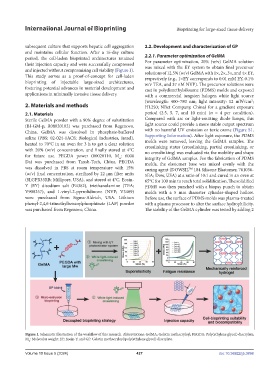Page 435 - IJB-10-5
P. 435
International Journal of Bioprinting Bioprinting for large-sized tissue delivery
subsequent culture that supports hepatic cell aggregation 2.2. Development and characterization of GP
and maintains cellular function. After a 16-day culture
period, the cell-laden bioprinted architectures retained 2.2.1. Parameter optimization of GelMA
their injection capacity and were successfully compressed For parameter optimization, 20% (w/v) GelMA solution
was mixed with the EY system to obtain final precursor
and injected without compromising cell viability (Figure 1). solutions of 12.5% (w/v) GelMA with 1×, 2×, 3×, and 4× EY,
This study serves as a proof-of-concept for cell-laden respectively (e.g., 1×EY corresponds to 0.01 mM EY, 0.1%
bioprinting of injectable large-sized architectures, w/v TEA, and 37 nM NVP). The precursor solutions were
fostering potential advances in material development and cast in polydimethylsiloxane (PDMS) molds and exposed
applications in minimally invasive tissue delivery. with a commercial tungsten halogen white light source
(wavelength: 400–780 nm; light intensity: 12 mW/cm ;
2
2. Materials and methods HL250; NBet Company, China) for a gradient exposure
2.1. Materials period (2.5, 5, 7, and 10 min) (n = 4 per condition).
Sterile GelMA powder with a 90% degree of substitution Compared with arc or light-emitting diode lamps, this
(BI-GM-p, R08020102) was purchased from Regenovo, light source could provide a more stable output spectrum
China. GelMA was dissolved in phosphate-buffered with no harmful UV emission or toxic ozone (Figure S1,
saline (PBS; 02-024-1ACS; Biological Industries, Israel), Supporting Information). After light exposure, the PDMS
heated to 70°C in an oven for 3 h to get a clear solution molds were removed, leaving the GelMA samples. The
crosslinking status (crosslinking, partial crosslinking, or
with 20% (w/v) concentration, and finally stored at 4°C no crosslinking) was evaluated via the mobility and shape
for future use. PEGDA power (80020110, M : 6000 integrity of GelMA samples. For the fabrication of PDMS
w
Da) was purchased from Tansh-Tech, China. PEGDA molds, the elastomer base was mixed evenly with the
was dissolved in PBS at room temperature with 15% curing agent (DOWSIL 184 Silicone Elastomer, 761036-
TM
(w/v) final concentration, sterilized by 22 μm filter units 5EA; Dow, USA) at a ratio of 10:1 and cured in an oven at
(SLGPR33RB; Millipore, USA), and stored at 4°C. Eosin- 65°C for 100 min to reach total solidification. The solidified
Y (EY) disodium salt (E4382), triethanolamine (TEA; PDMS was then punched with a biopsy punch to obtain
V900257), and 1-vinyl-2-pyrrolidinone (NVP; V3409) molds with a 5 mm diameter cylinder-shaped hollow.
were purchased from Sigma-Aldrich, USA. Lithium Before use, the surface of PDMS molds was plasma-treated
phenyl-2,4,6-trimethylbenzoylphosphinate (LAP) powder with a plasma processor to alter the surface hydrophilicity.
was purchased from Regenovo, China. The stability of the GelMA cylinder was tested by adding 2
Figure 1. Schematic illustration of the workflow of this research. Abbreviations: GelMA: Gelatin methacryloyl; PEGDA: Poly(ethylene glycol) diacrylate;
M : Molecular weight; EY: Eosin-Y; and GP: Gelatin methacryloyl/poly(ethylene glycol) diacrylate.
w
Volume 10 Issue 5 (2024) 427 doi: 10.36922/ijb.3898

